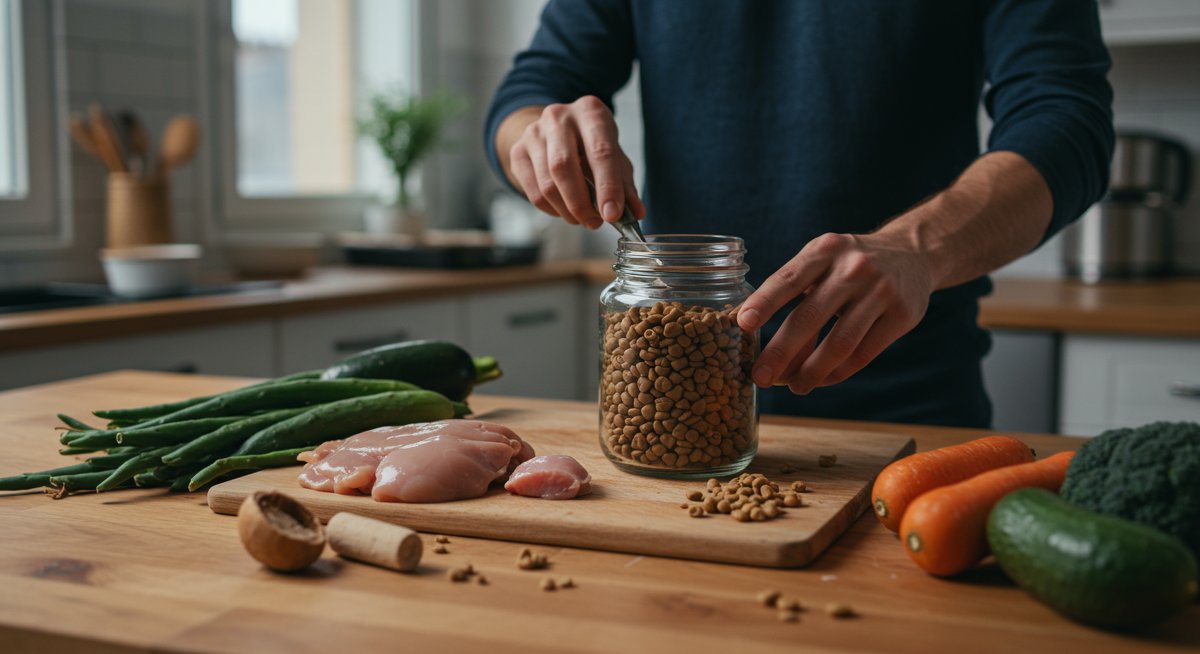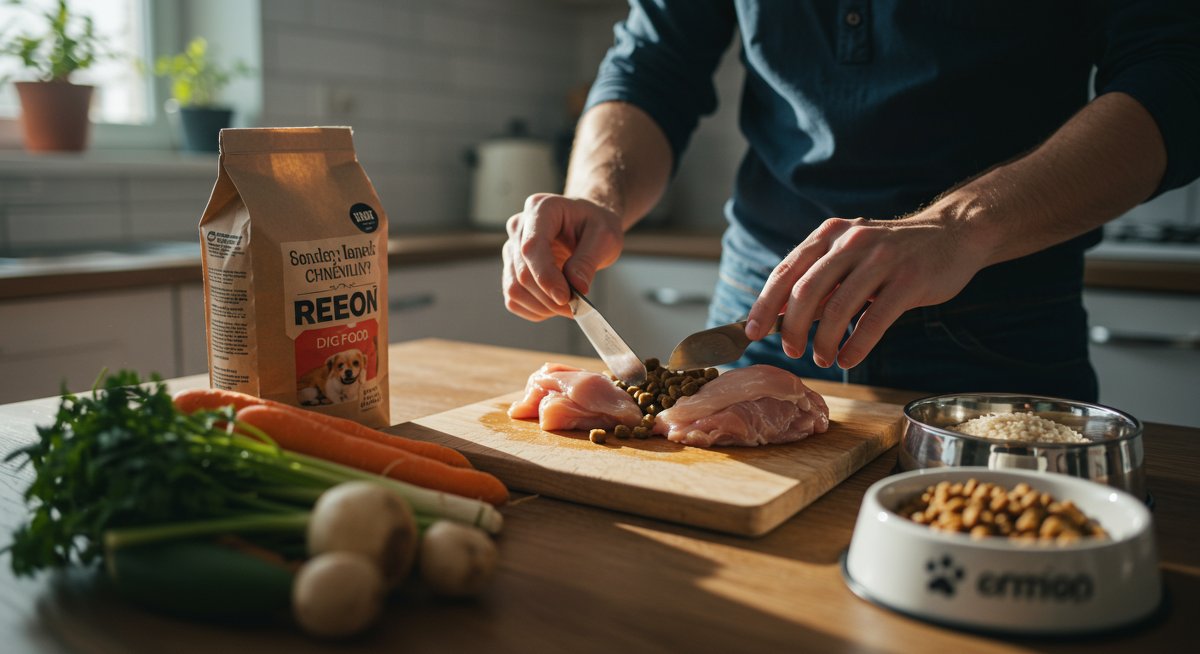Bringing a dog into your life is a joy, but it also comes with the responsibility of providing the best care possible. One of the most critical aspects of dog ownership is nutrition. While commercial dog food offers convenience, have you considered homemade dog food? This guide explores the many benefits of preparing your dog's meals at home, providing you with recipes, ingredient advice, and practical tips for a happy, healthy pup. It's about more than just feeding your dog; it's about showing them how much you care.

Why Homemade Dog Food? The Benefits Beyond the Bowl
So, why make dog food from scratch? It's a question many dog owners ask. The answer is compelling. When you choose to make your dog's food, you gain complete control over the ingredients. You know exactly what's going into their bowl, avoiding the often-hidden fillers, preservatives, and potentially allergenic ingredients found in some commercial foods. This control can be particularly beneficial for dogs with sensitivities or allergies.
In my experience, many commercial dog foods, even those labeled "premium," can contain ingredients that don't fully meet a dog's nutritional needs. Making food at home allows you to tailor meals to your dog's specific breed, age, activity level, and health conditions. For example, a senior dog might need more easily digestible protein and joint-supporting ingredients, while a high-energy breed might need a diet richer in calories.
Furthermore, homemade dog food can often be more affordable, especially when you buy ingredients in bulk. It allows you to use fresh, whole foods, packed with vitamins, minerals, and antioxidants that boost your dog's immune system and overall health. This can translate into fewer vet visits and a longer, healthier life for your furry friend. You can also reduce your environmental impact by using less packaging compared to buying pre-packaged food. And let's be honest, the bond you create while preparing your dog's meals is priceless.
- Example 1: A dog owner with a Labrador Retriever struggling with skin allergies switched to a homemade diet. By eliminating common allergens like wheat and corn, they were able to significantly reduce their dog's itching and scratching, improving their quality of life. This resulted in a $100+ savings each month on allergy medication as well.
- Example 2: A senior dog with arthritis benefited greatly from a homemade diet rich in glucosamine and chondroitin (often added as supplements in commercial foods), combined with lean protein and vegetables. The owner reported increased mobility and a more comfortable pet.
- Example 3: A family on a tight budget was able to provide their energetic Border Collie with a nutritionally balanced diet at a lower cost by making their own food. They bought ingredients in bulk and planned their meals, saving approximately $75 a month compared to buying high-quality commercial food.
Essential Ingredients for Homemade Dog Food: Building a Balanced Bowl
Creating a balanced homemade diet for your dog requires understanding the key components of canine nutrition. It's important to get the right balance of macronutrients (proteins, fats, and carbohydrates) and micronutrients (vitamins and minerals) to ensure optimal health. You can't just throw some leftovers in a bowl! It takes some planning.
- Protein: This is the foundation of your dog's diet, providing the building blocks for muscles, tissues, and enzymes. Choose high-quality, lean protein sources like cooked chicken, turkey, beef, or fish (ensure all bones are removed). Eggs are also a great source of protein and essential amino acids. Always cook meat thoroughly to eliminate the risk of bacterial contamination.
- Healthy Fats: Fats are crucial for energy, hormone production, and healthy skin and coat. Include sources like fish oil (excellent for omega-3 fatty acids), flaxseed oil, or small amounts of olive oil. Avoid excessive amounts of saturated fats.
- Complex Carbohydrates: These provide energy and fiber. Good choices include cooked sweet potatoes, brown rice, oats, and quinoa. Avoid simple carbohydrates like white bread and pasta, which offer little nutritional value.
- Vegetables: Offer a variety of cooked or steamed vegetables like carrots, green beans, broccoli, spinach, and peas. These provide essential vitamins, minerals, and fiber. Avoid onions, garlic, and chives, which are toxic to dogs.
- Fruits: Fruits like blueberries, strawberries, and apples (without the seeds) can be added in moderation for extra vitamins and antioxidants. Too much fruit can lead to digestive upset due to the high sugar content.
Here are some common mistakes to avoid:
- Relying solely on one protein source: This can lead to nutritional deficiencies. Vary protein sources for a balanced diet.
- Adding too many carbs: Dogs don't need as many carbs as humans. Overdoing it can lead to weight gain.
- Not consulting a vet or veterinary nutritionist: It's essential to ensure your homemade recipes meet your dog's specific needs.
Expert Tip: Always introduce new ingredients gradually to monitor for any digestive issues or allergies. Keep a food diary to track your dog's reactions to different foods.
- Example 1: For a small breed dog, consider a recipe featuring cooked chicken, brown rice, steamed carrots, and a sprinkle of flaxseed oil. This provides lean protein, easily digestible carbs, and essential fatty acids.
- Example 2: For a larger, active breed, try a recipe with beef, sweet potatoes, spinach, and a small amount of quinoa. This supports muscle development, energy, and overall health.
- Example 3: For a dog with sensitive digestion, choose easily digestible ingredients like cooked turkey, white rice, and pureed pumpkin. Pumpkin is a great source of fiber and can aid in digestion.

Homemade Dog Food Recipes: Getting Started in the Kitchen
Now for the fun part: the recipes! Here are a couple of simple and balanced homemade dog food recipes to get you started. Remember, these are just examples, and it's crucial to adjust the ingredients and portion sizes based on your dog's individual needs and your veterinarian's recommendations. It's like cooking for yourself, just for a furry friend.
Recipe 1: Chicken and Rice Delight (Suitable for most dogs)
- 1 cup cooked, shredded chicken (boneless, skinless)
- 1/2 cup cooked brown rice
- 1/4 cup steamed carrots, chopped
- 1 tablespoon of peas
- 1 teaspoon of fish oil
Instructions: Mix all ingredients thoroughly in a bowl. Serve at room temperature.
Recipe 2: Beef and Sweet Potato Bowl (Great for active dogs)
- 1 cup cooked, ground beef (lean)
- 1/2 cup cooked sweet potato, mashed
- 1/4 cup steamed broccoli, chopped
- 1 tablespoon of quinoa, cooked
- 1 teaspoon of olive oil
Instructions: Combine all ingredients. Adjust portion sizes based on your dog's weight, age, and activity level.
Common mistakes:
- Not measuring ingredients accurately: Use measuring cups and spoons for consistency.
- Overfeeding: Portion control is key to preventing weight gain.
- Skipping essential ingredients: Make sure you're including protein, carbs, fats, and vegetables or fruits.
Expert tip: Cook a large batch of food on the weekend to save time during the week. Store in individual portions in the refrigerator or freezer.
- Example 1: A family uses the Chicken and Rice Delight recipe for their senior dog with good results. They reduced the chicken portion a little to avoid too much protein as advised by the vet.
- Example 2: A couple makes the Beef and Sweet Potato Bowl for their energetic working dog, who loves it. They increased the portion size on days the dog did more running/activity to keep up with his energy needs.
- Example 3: A single person found it easy to cook a big batch of homemade dog food and freeze individual servings to save on time and waste. She found it was even cheaper than store bought food.
Portioning, Storage, and FAQs: Keeping It Fresh and Safe
Once you've got your recipes down, it's time to focus on how much to feed your dog and how to store the food properly to ensure its safety. It's not enough to simply create a healthy meal; you need to get the right amount and keep it safe.
Portioning: The amount of food your dog needs depends on several factors, including their weight, age, breed, activity level, and metabolism. A good starting point is to follow the guidelines provided by your veterinarian. Typically, dogs need about 20-30 calories per pound of body weight per day.
- For smaller dogs: A half-cup to one cup of food twice a day may be sufficient.
- For larger, active breeds: They may need two to three cups twice a day, or more, depending on their activity level.
Storage: Proper storage is essential to prevent spoilage and bacterial growth. Store homemade dog food in airtight containers. Refrigerate food for up to three to four days. Freeze any excess food in individual portions for up to two months. Thaw frozen portions in the refrigerator overnight before serving.
FAQs
- Q: How do I transition my dog to homemade food? A: Gradually introduce the new food over 5-7 days, mixing increasing amounts of homemade food with the commercial food. Watch for any digestive upset.
- Q: Can I give my dog bones? A: Cooked bones can splinter and cause serious injury. Raw, meaty bones are a safer option, but always supervise your dog and choose appropriate sizes for their breed. This is a decision best discussed with your vet, as it varies by dog and situation.
- Q: What about supplements? A: You may need to add supplements to ensure your dog gets all the necessary nutrients. Consult with your vet about the best supplements for your dog's needs (e.g., glucosamine for joint health). Do not self-medicate your dog.
Common mistakes:
- Freezing food in large, undivided containers: This makes it difficult to portion out. Always use individual portions.
- Not monitoring your dog's weight: Adjust portion sizes based on your dog's body condition score.
- Using old, spoiled ingredients: Always use fresh ingredients.
Expert Tip: Invest in a good kitchen scale for accurate measurements. This can help prevent overfeeding or underfeeding. You can get a good kitchen scale for $20 - $30 from Amazon or Target.
- Example 1: A dog owner starts with 1.5 cups of homemade food twice a day for their medium-sized dog. After a month, they noticed their dog was gaining weight, so they reduced the portion size to 1.25 cups twice a day, which corrected the issue.
- Example 2: A family uses the freezer method to store portions of homemade dog food. They label and date each container to ensure they are used within the recommended timeframe.
- Example 3: A new dog owner was confused about portion sizes. She met with the vet for a quick consultation to determine the right amount for her dog. This helped her keep her dog healthy and happy.
Taking the Next Steps: Making Homemade Dog Food a Success
Creating homemade dog food is a rewarding way to enhance your dog's health and well-being. It allows you to build a deeper bond with your pet while ensuring they receive optimal nutrition. By carefully selecting ingredients, following balanced recipes, and implementing safe storage practices, you can create a diet that is both delicious and beneficial for your dog. Remember, it's an ongoing process of learning and adapting to your dog's individual needs.
If you're ready to take your dog's health to the next level, I encourage you to consult with your veterinarian to discuss your dog's specific dietary needs and get their professional advice. They can help you create a customized plan that ensures your furry friend thrives.
And hey, if you're on this journey too, I’d love to hear how it goes for you. Let me know how it goes in the comments!